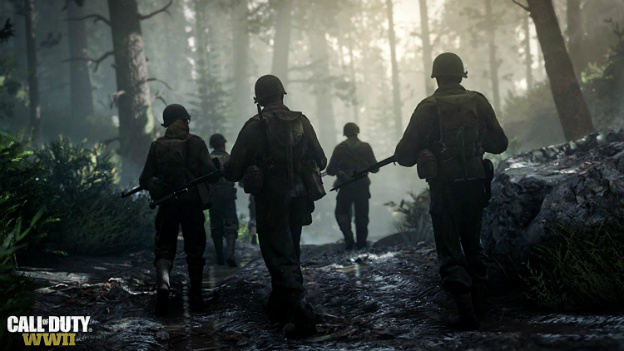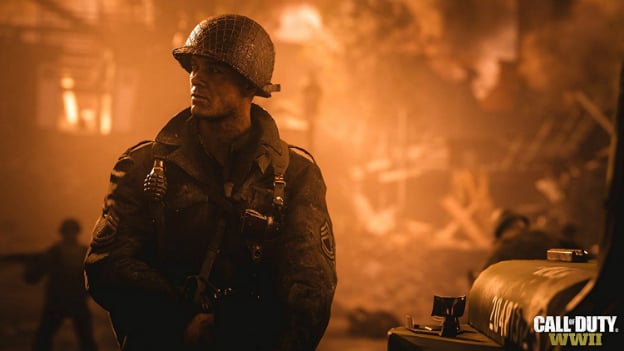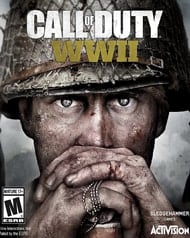COD: WWII Is an Old Dog with New Tricks
When it rains it pours, and in 2017, it’s cloudy with a chance of Nazi scum. Not long after the alternate-history camp and aggression of Wolfenstein II , I find myself back with boots on the ground in the real history of World War II. After several years of modern and science fiction trappings, Call of Duty is back to its roots, in a way that feels appropriate. It was time to try something new, and never can a year be more appropriately labeled with the “everything old is new again” cliché than this. Sans context, Call of Duty: WWII feels like a reaction to DICE’s successful Battlefield 1 or Call of Duty: Infinite Warfare ’s less than astronomical sales. In reality, these games have three-year dev cycles, so it’s all just how things go: messy coincidence. But it feels right; going back to the well when we’re knee-deep in a monumental console generation is a great way to look at that well from a new angle.
We haven’t been to World War II in Call of Duty since World at War nearly a decade ago. That and Modern Warfare before it were the beginnings of what Call of Duty is now, a mix between a huge, bombastic single-player campaign and a multiplayer mode that is treated as almost a separate game entirely. The stories would become less about setting and history for obvious reasons, and more about the various teams trying to tell spectacle and character-driven, movie-like stories. The extent that this has been successful is debatable, but the effectiveness of Modern Warfare 2 in particular is undeniable. Call of Duty: WWII ’s campaign is a little of column A, a little of B. It takes real history and tries to inject a Band of Brothers -inspired story into the re-enactment style of old.
Call of Duty: WWII takes an admirable approach, with a campaign that defies its short length with plenty of variety throughout. However, it lacks a certain confidence, often tripping over itself to make sure it hits the “respect the troops” bulletpoints at the cost of its attempts at “war is bad” imagery, something that past Call of Duty games, not based on real wars, weren’t afraid to lean on a bit harder. It comes off as fluffy more often than it should, with the stink of a Lifetime movie tone all over it. This is especially evident when it tries to endear us to the Texan good ol’ boy protagonist, Daniels. The “band of brothers” is largely a team of game mechanics and one-liner dispensers who hardly get enough screentime or development to warrant a bond on the part of the player. The only other character who really does is often there for bad things to constantly happen to, to wring sympathy from the player without the story taking the time to earn it. It’s tough to fit an HBO miniseries into a six-hour FPS campaign.
One chapter specifically, however, veers into “Walking Simulator” territory and manages to be very good and intriguing. The player takes over the role of a woman serving in the French Resistance on an undercover mission sneaking through a Nazi mansion. It’s very Wolfenstein , with an intense face-to-face encounter with a Nazi official threatening to violently blow your cover. Unfortunately, it devolves into an extremely banal stealth sequence, something the Call of Duty: WWII campaign continues to force on the player in its latter half. The stealth system feels like an item on a list, rather than something fully baked, and when paired with a story full of war movie tropes and underdeveloped characters, it goes in one ear and out the other. It’s fun to play, but not fun to remember.
This of course brings us to multiplayer, the place where most Call of Duty fans will spend the majority of their time. Multiplayer is split into two major modes, the regular multiplayer and Zombies. Both of these modes have their own set of stuff to unlock, much of it overlapping, but presenting itself in slightly different ways. Zombies is more of a silly distraction, despite the fun actor cameos and goofy camp. Multiplayer is where the population lives and thrives, and in an effort to feed that, Sledgehammer introduced the new Headquarters. Headquarters ostensibly broke the servers at launch, and as a result was largely a ghost town during Call of Duty: WWII ’s opening weekend. In theory, it’s a Destiny -like hub in which players can interact with each other, including 1v1 matches and other group activities. Players can even watch each other open loot boxes, which is… weird.

The thing is, Headquarters seems like it’s really trying to be like Destiny or another game big on social interaction, but in execution it feels more like a bloated gimmick. Driving that home is the fact that actually getting into a match is a matter of pausing the game wherever you stand and sifting through menus. If you want, you can ignore it entirely. You may want to, unless loot boxes and 1v1 sound appealing anyway, as the whole thing is cumbersome enough to move around when you aren’t wading through a bunch of other players. It’s a neat idea, but could have used a bit more streamlining.

Speaking of streamlining, one of the other big online hooks in Call of Duty: WWII is Divisions. Instead of a ton of loadout customization, you now pick a class at the beginning, with options to switch around opening up as you play. Each Division starts you off with a primary and secondary weapon, along with some specific abilities. As you play and rank up, you unlock more, as well as coins that let you go off-script a bit. Considering the game doesn’t really instruct you on how anything works beyond the bare minimum, this is really helpful and gets you on the battlefield a lot faster, really minimizing time spent flipping through menus.
The Call of Duty: WWII matches themselves are what you expect, and the in-game flow feels a bit better compared to pre-release beta tests. It’s still a specific kind of shooter, more arcade-like with little time between the time it takes between getting shot at and dying. But the tools available fit that theme and respawning is usually just as quick. The new War mode is the star of the show, with a series of progressing objectives that play out little mini-stories despite the online multiplayer setting. Highlights also include an arena-style multiple checkpoint mode, and sillier fare like tossing a ball around. Despite the sounds and horrors of WWII in the background, Call of Duty is still Call of Duty .

Zombies, despite the resources poured into its presentation, feels like a sideshow. It’s odd to see everything crammed into menus, juxtaposed to the grand ambitions of Headquarters on the other side of multiplayer. It’s also confusing, as the prologue, once again, barely tells you how things work. Much of Call of Duty: WWII assumes you already speak the language, and anyone trying this stuff out for the first time may feel discouraged as they bumble around trying to figure out what does what. Objective markers may have been helpful, for starters, as much of my experience was teammates opening the first door, then leaving it to me to seek out more stuff to do. Balance also feels off, with teammate revival being slow and recovering from a death being nearly impossible after about ten waves or so, due to you losing all your stuff when you die. Is this designed to make loot boxes more attractive? It sure feels like it.
Overall what we have here is another Call of Duty , which means exactly what you think that means. Going back to basics will likely please the fanbase, which was vocally growing tired of the sci-fi stuff. The gameplay loops online are much less complicated, heading back to the “freeze tag with guns” and away from the more complex movement systems. The campaign feels like a greatest hits of Call of Duty moments, but falls short of standing out on its own, despite looking nice and being well-produced. Headquarters feels like an unstable attempt at Destiny -fying Call of Duty , but the amount of online multiplayer content available will help people overlook flaws and perhaps allow for future iteration. Call of Duty: WWII is a solid entry, but it feels more safe and standard than it should, especially standing next to its peers that took similar ideas and did more.
RATING OUT OF 5 RATING DESCRIPTION 4.0 Graphics
It looks like World War II probably did! There’s a lot going on, with bonus ordinance and gunfire not created by other players constantly filling your field of view. The frame rate never stutter, but campaign cutscenes do hitch and stutter sometimes though, and the animations there feel more video game-y than you’d expect from AAA games. 5.0 Control
Call of Duty: WWII is nice and simple. You can pick it up with any FPS experience and find the buttons behave as you might expect them to. 4.0 Music / Sound FX / Voice Acting
The generic, serious orchestral score does its job, but the real star of the show is the sound effects. That rifle reload that accompanies the title screen is eerie in its effectiveness. 3.5 Play Value
A well-produced, but ultimately bland campaign brings this down, along with Headquarters and Zombies feeling undercooked. But several new modes introduced in normal Multiplayer will keep Call of Duty afloat until next year. 4.0 Overall Rating – Great
Not an average. See Rating legend below for a final score breakdown.
| Review Rating Legend | |||
|---|---|---|---|
| 0.1 – 1.9 = Avoid | 2.5 – 2.9 = Average | 3.5 – 3.9 = Good | 4.5 – 4.9 = Must Buy |
| 2.0 – 2.4 = Poor | 3.0 – 3.4 = Fair | 4.0 – 4.4 = Great | 5.0 = The Best |
Game Features:
